Ecological Systems Theory and Child Marriages in the Global South
VerifiedAdded on 2023/05/30
|7
|1758
|93
Essay
AI Summary
This essay provides an overview of child marriages in the Global South, focusing on regions like Latin America, Africa, Asia, and Oceania. It highlights the high rates of child marriage, particularly in countries like Bangladesh and Nigeria, referencing UNICEF data. The essay explores the economic, historical, cultural, and political factors that contribute to this issue. It applies Urie Bronfenbrenner's ecological systems theory to analyze the various levels of influence on a child's development, from the immediate microsystem to the broader macrosystem and chronosystem. The analysis considers cultural differences, such as those in Tibetan, Chinese, and Japanese child-rearing practices, and concludes that children in the Global South are often more culturally oriented due to the interplay of economic, social, and political factors, leading them to perpetuate cultural traditions across generations. Find more essays and study tools on Desklib.

Running Head: EARLY MARRIAGES IN THE GLOBAL SOUTH 0
Child Marriages in the Global South
Student’s Name
11/29/2018
Child Marriages in the Global South
Student’s Name
11/29/2018
Paraphrase This Document
Need a fresh take? Get an instant paraphrase of this document with our AI Paraphraser
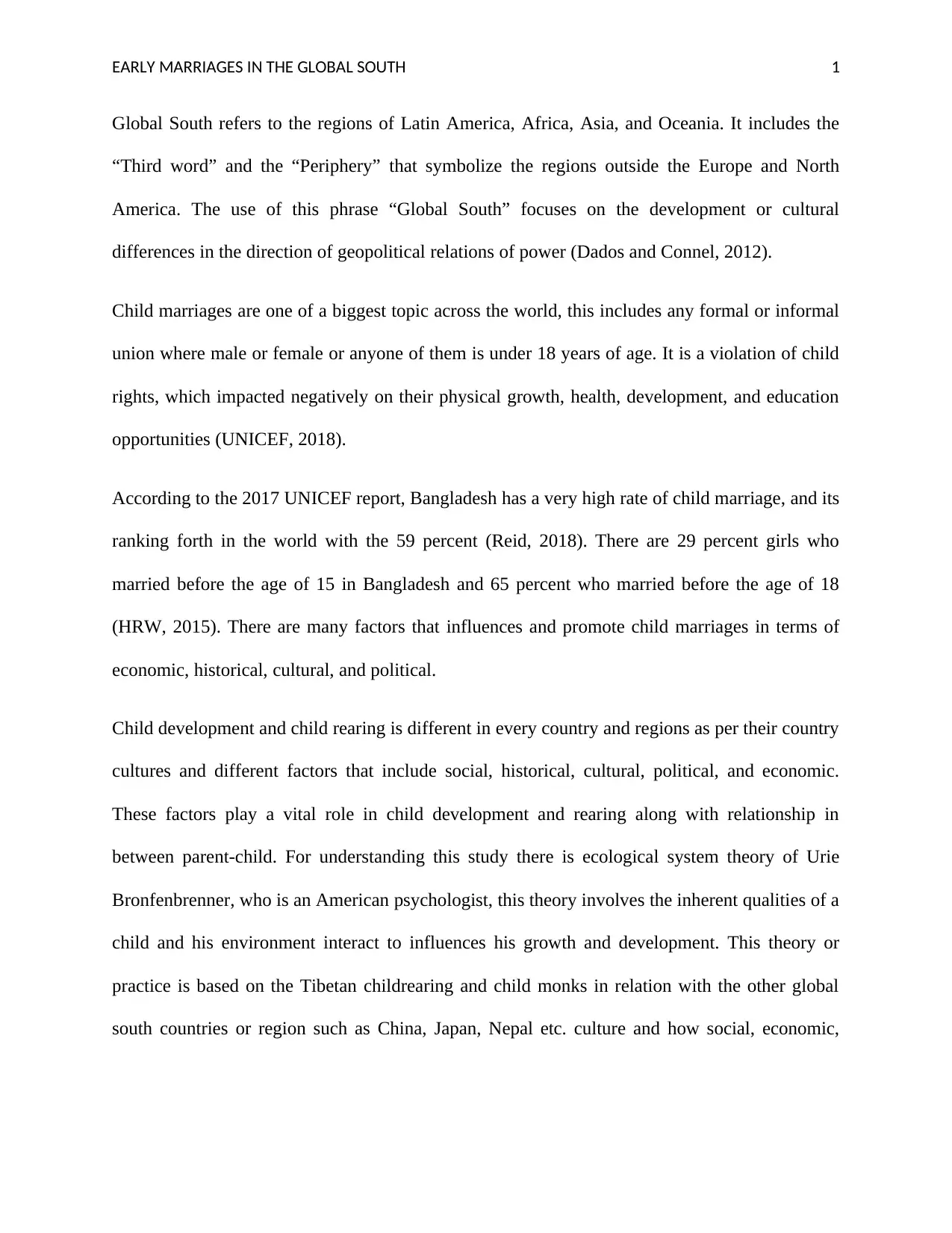
EARLY MARRIAGES IN THE GLOBAL SOUTH 1
Global South refers to the regions of Latin America, Africa, Asia, and Oceania. It includes the
“Third word” and the “Periphery” that symbolize the regions outside the Europe and North
America. The use of this phrase “Global South” focuses on the development or cultural
differences in the direction of geopolitical relations of power (Dados and Connel, 2012).
Child marriages are one of a biggest topic across the world, this includes any formal or informal
union where male or female or anyone of them is under 18 years of age. It is a violation of child
rights, which impacted negatively on their physical growth, health, development, and education
opportunities (UNICEF, 2018).
According to the 2017 UNICEF report, Bangladesh has a very high rate of child marriage, and its
ranking forth in the world with the 59 percent (Reid, 2018). There are 29 percent girls who
married before the age of 15 in Bangladesh and 65 percent who married before the age of 18
(HRW, 2015). There are many factors that influences and promote child marriages in terms of
economic, historical, cultural, and political.
Child development and child rearing is different in every country and regions as per their country
cultures and different factors that include social, historical, cultural, political, and economic.
These factors play a vital role in child development and rearing along with relationship in
between parent-child. For understanding this study there is ecological system theory of Urie
Bronfenbrenner, who is an American psychologist, this theory involves the inherent qualities of a
child and his environment interact to influences his growth and development. This theory or
practice is based on the Tibetan childrearing and child monks in relation with the other global
south countries or region such as China, Japan, Nepal etc. culture and how social, economic,
Global South refers to the regions of Latin America, Africa, Asia, and Oceania. It includes the
“Third word” and the “Periphery” that symbolize the regions outside the Europe and North
America. The use of this phrase “Global South” focuses on the development or cultural
differences in the direction of geopolitical relations of power (Dados and Connel, 2012).
Child marriages are one of a biggest topic across the world, this includes any formal or informal
union where male or female or anyone of them is under 18 years of age. It is a violation of child
rights, which impacted negatively on their physical growth, health, development, and education
opportunities (UNICEF, 2018).
According to the 2017 UNICEF report, Bangladesh has a very high rate of child marriage, and its
ranking forth in the world with the 59 percent (Reid, 2018). There are 29 percent girls who
married before the age of 15 in Bangladesh and 65 percent who married before the age of 18
(HRW, 2015). There are many factors that influences and promote child marriages in terms of
economic, historical, cultural, and political.
Child development and child rearing is different in every country and regions as per their country
cultures and different factors that include social, historical, cultural, political, and economic.
These factors play a vital role in child development and rearing along with relationship in
between parent-child. For understanding this study there is ecological system theory of Urie
Bronfenbrenner, who is an American psychologist, this theory involves the inherent qualities of a
child and his environment interact to influences his growth and development. This theory or
practice is based on the Tibetan childrearing and child monks in relation with the other global
south countries or region such as China, Japan, Nepal etc. culture and how social, economic,
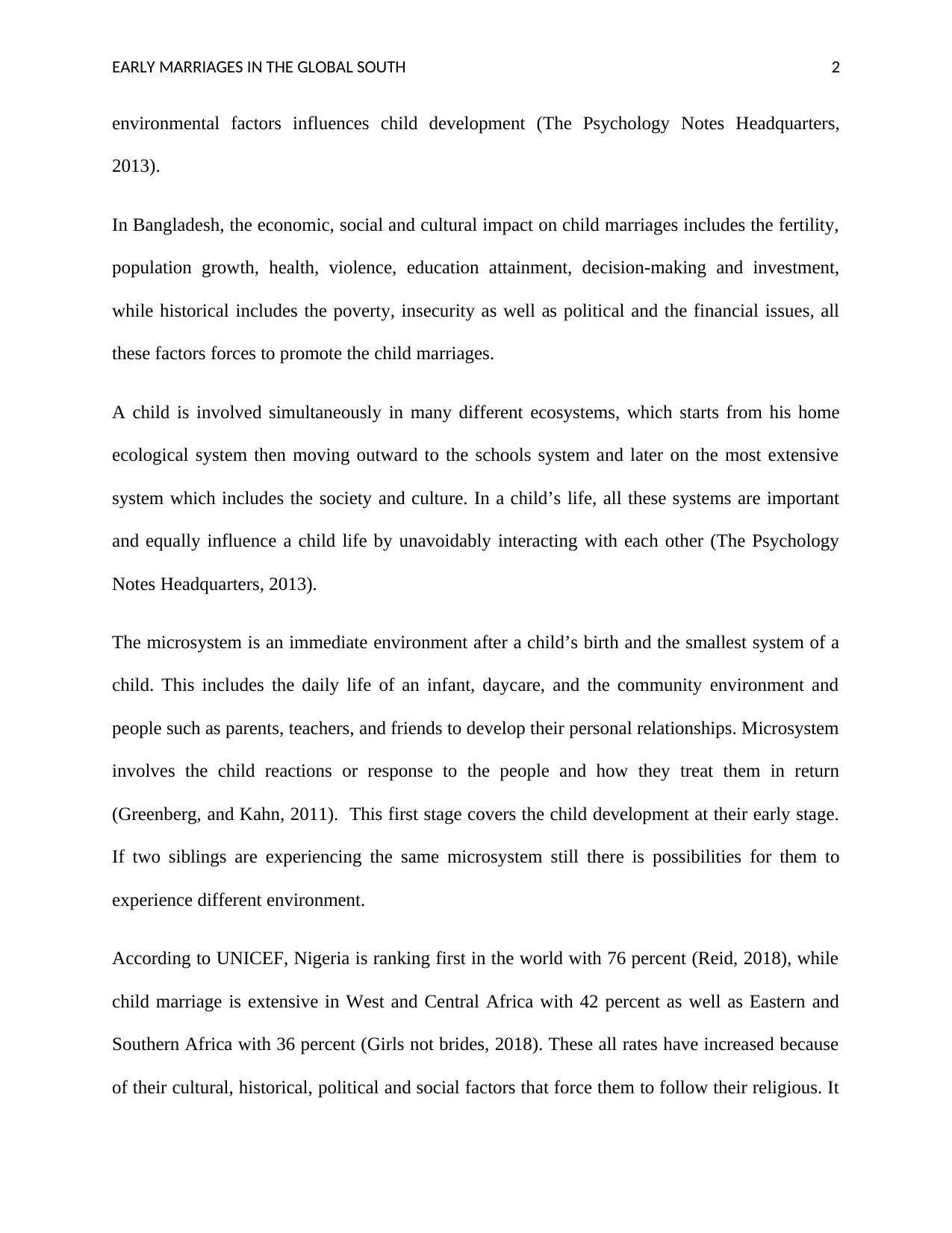
EARLY MARRIAGES IN THE GLOBAL SOUTH 2
environmental factors influences child development (The Psychology Notes Headquarters,
2013).
In Bangladesh, the economic, social and cultural impact on child marriages includes the fertility,
population growth, health, violence, education attainment, decision-making and investment,
while historical includes the poverty, insecurity as well as political and the financial issues, all
these factors forces to promote the child marriages.
A child is involved simultaneously in many different ecosystems, which starts from his home
ecological system then moving outward to the schools system and later on the most extensive
system which includes the society and culture. In a child’s life, all these systems are important
and equally influence a child life by unavoidably interacting with each other (The Psychology
Notes Headquarters, 2013).
The microsystem is an immediate environment after a child’s birth and the smallest system of a
child. This includes the daily life of an infant, daycare, and the community environment and
people such as parents, teachers, and friends to develop their personal relationships. Microsystem
involves the child reactions or response to the people and how they treat them in return
(Greenberg, and Kahn, 2011). This first stage covers the child development at their early stage.
If two siblings are experiencing the same microsystem still there is possibilities for them to
experience different environment.
According to UNICEF, Nigeria is ranking first in the world with 76 percent (Reid, 2018), while
child marriage is extensive in West and Central Africa with 42 percent as well as Eastern and
Southern Africa with 36 percent (Girls not brides, 2018). These all rates have increased because
of their cultural, historical, political and social factors that force them to follow their religious. It
environmental factors influences child development (The Psychology Notes Headquarters,
2013).
In Bangladesh, the economic, social and cultural impact on child marriages includes the fertility,
population growth, health, violence, education attainment, decision-making and investment,
while historical includes the poverty, insecurity as well as political and the financial issues, all
these factors forces to promote the child marriages.
A child is involved simultaneously in many different ecosystems, which starts from his home
ecological system then moving outward to the schools system and later on the most extensive
system which includes the society and culture. In a child’s life, all these systems are important
and equally influence a child life by unavoidably interacting with each other (The Psychology
Notes Headquarters, 2013).
The microsystem is an immediate environment after a child’s birth and the smallest system of a
child. This includes the daily life of an infant, daycare, and the community environment and
people such as parents, teachers, and friends to develop their personal relationships. Microsystem
involves the child reactions or response to the people and how they treat them in return
(Greenberg, and Kahn, 2011). This first stage covers the child development at their early stage.
If two siblings are experiencing the same microsystem still there is possibilities for them to
experience different environment.
According to UNICEF, Nigeria is ranking first in the world with 76 percent (Reid, 2018), while
child marriage is extensive in West and Central Africa with 42 percent as well as Eastern and
Southern Africa with 36 percent (Girls not brides, 2018). These all rates have increased because
of their cultural, historical, political and social factors that force them to follow their religious. It
⊘ This is a preview!⊘
Do you want full access?
Subscribe today to unlock all pages.

Trusted by 1+ million students worldwide
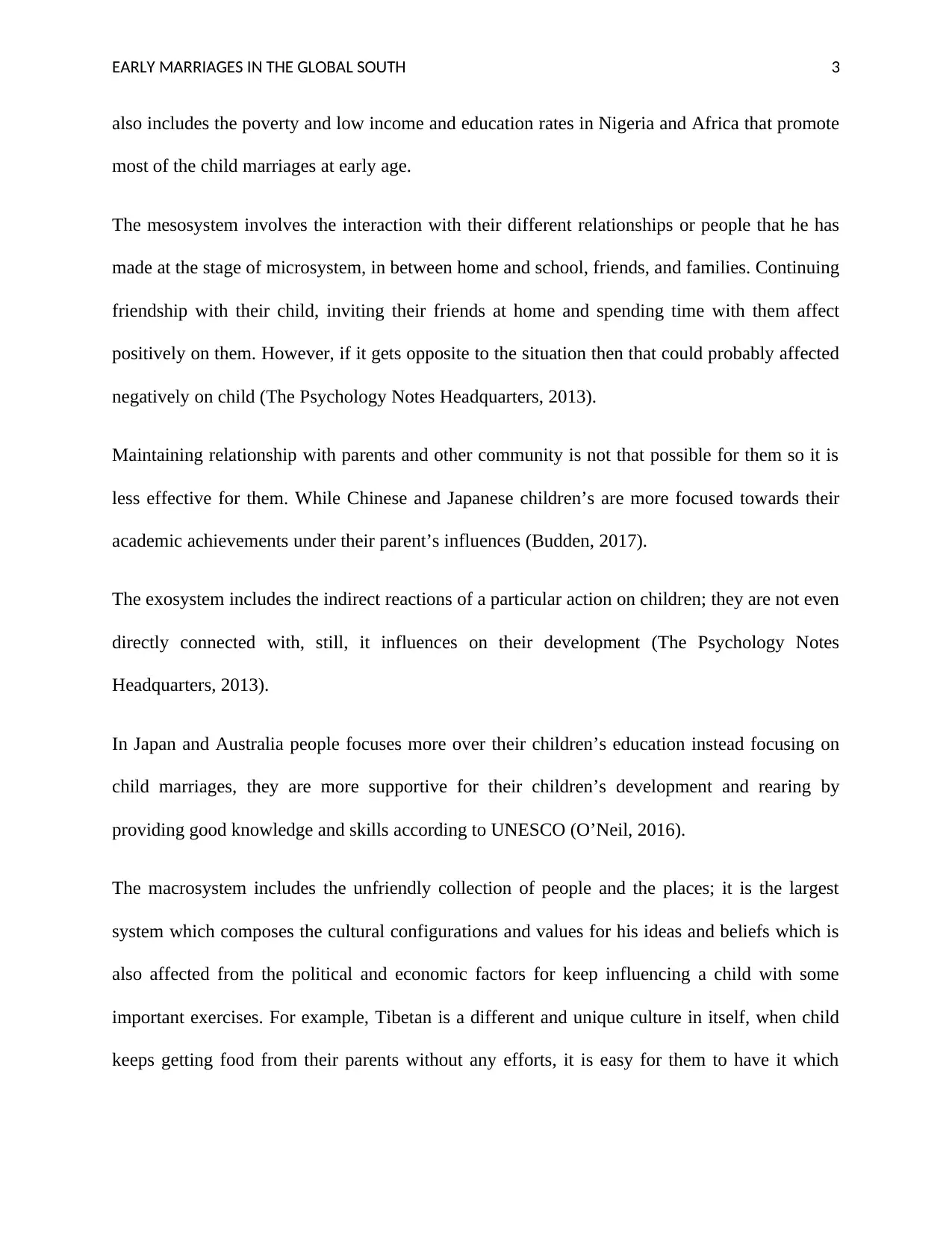
EARLY MARRIAGES IN THE GLOBAL SOUTH 3
also includes the poverty and low income and education rates in Nigeria and Africa that promote
most of the child marriages at early age.
The mesosystem involves the interaction with their different relationships or people that he has
made at the stage of microsystem, in between home and school, friends, and families. Continuing
friendship with their child, inviting their friends at home and spending time with them affect
positively on them. However, if it gets opposite to the situation then that could probably affected
negatively on child (The Psychology Notes Headquarters, 2013).
Maintaining relationship with parents and other community is not that possible for them so it is
less effective for them. While Chinese and Japanese children’s are more focused towards their
academic achievements under their parent’s influences (Budden, 2017).
The exosystem includes the indirect reactions of a particular action on children; they are not even
directly connected with, still, it influences on their development (The Psychology Notes
Headquarters, 2013).
In Japan and Australia people focuses more over their children’s education instead focusing on
child marriages, they are more supportive for their children’s development and rearing by
providing good knowledge and skills according to UNESCO (O’Neil, 2016).
The macrosystem includes the unfriendly collection of people and the places; it is the largest
system which composes the cultural configurations and values for his ideas and beliefs which is
also affected from the political and economic factors for keep influencing a child with some
important exercises. For example, Tibetan is a different and unique culture in itself, when child
keeps getting food from their parents without any efforts, it is easy for them to have it which
also includes the poverty and low income and education rates in Nigeria and Africa that promote
most of the child marriages at early age.
The mesosystem involves the interaction with their different relationships or people that he has
made at the stage of microsystem, in between home and school, friends, and families. Continuing
friendship with their child, inviting their friends at home and spending time with them affect
positively on them. However, if it gets opposite to the situation then that could probably affected
negatively on child (The Psychology Notes Headquarters, 2013).
Maintaining relationship with parents and other community is not that possible for them so it is
less effective for them. While Chinese and Japanese children’s are more focused towards their
academic achievements under their parent’s influences (Budden, 2017).
The exosystem includes the indirect reactions of a particular action on children; they are not even
directly connected with, still, it influences on their development (The Psychology Notes
Headquarters, 2013).
In Japan and Australia people focuses more over their children’s education instead focusing on
child marriages, they are more supportive for their children’s development and rearing by
providing good knowledge and skills according to UNESCO (O’Neil, 2016).
The macrosystem includes the unfriendly collection of people and the places; it is the largest
system which composes the cultural configurations and values for his ideas and beliefs which is
also affected from the political and economic factors for keep influencing a child with some
important exercises. For example, Tibetan is a different and unique culture in itself, when child
keeps getting food from their parents without any efforts, it is easy for them to have it which
Paraphrase This Document
Need a fresh take? Get an instant paraphrase of this document with our AI Paraphraser
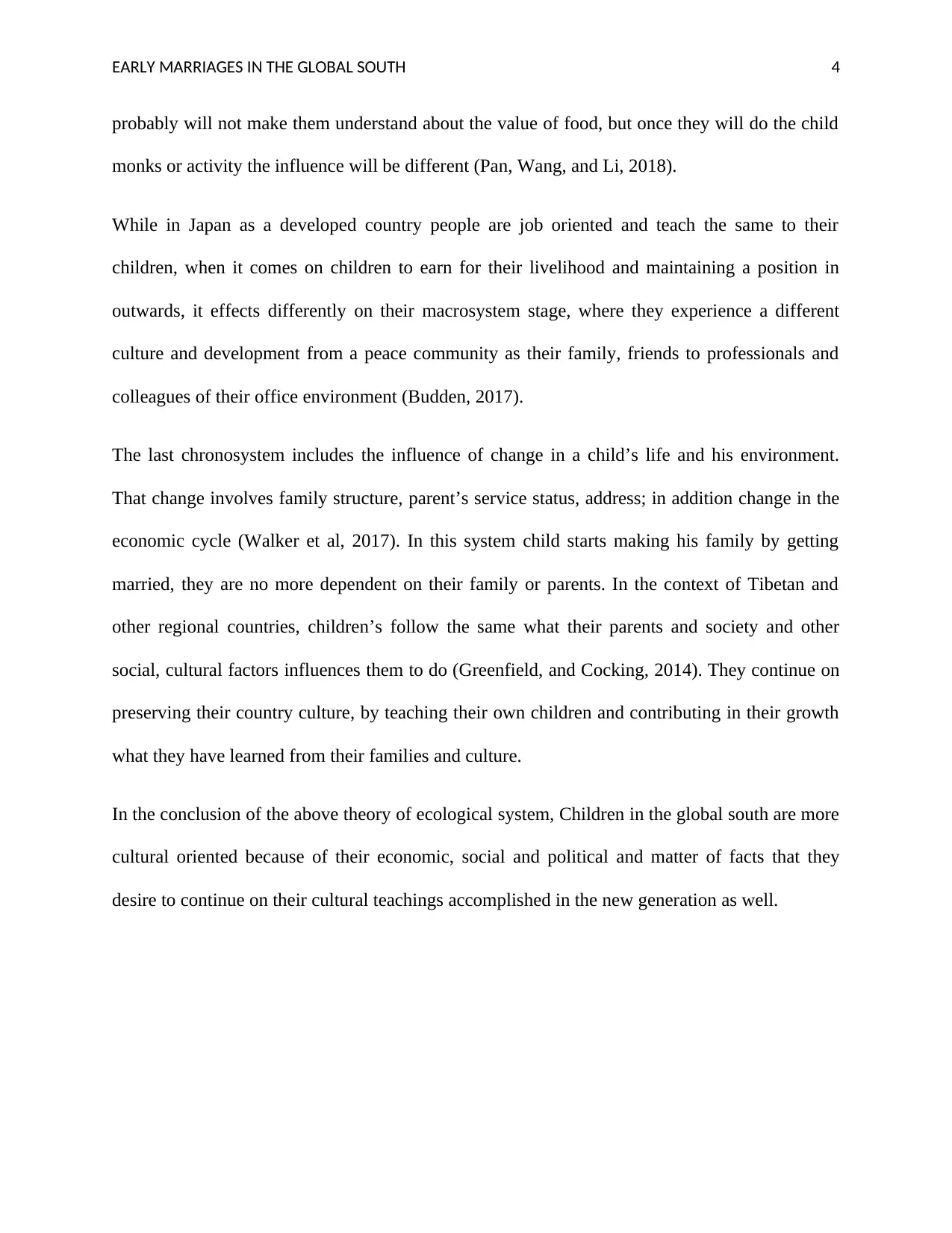
EARLY MARRIAGES IN THE GLOBAL SOUTH 4
probably will not make them understand about the value of food, but once they will do the child
monks or activity the influence will be different (Pan, Wang, and Li, 2018).
While in Japan as a developed country people are job oriented and teach the same to their
children, when it comes on children to earn for their livelihood and maintaining a position in
outwards, it effects differently on their macrosystem stage, where they experience a different
culture and development from a peace community as their family, friends to professionals and
colleagues of their office environment (Budden, 2017).
The last chronosystem includes the influence of change in a child’s life and his environment.
That change involves family structure, parent’s service status, address; in addition change in the
economic cycle (Walker et al, 2017). In this system child starts making his family by getting
married, they are no more dependent on their family or parents. In the context of Tibetan and
other regional countries, children’s follow the same what their parents and society and other
social, cultural factors influences them to do (Greenfield, and Cocking, 2014). They continue on
preserving their country culture, by teaching their own children and contributing in their growth
what they have learned from their families and culture.
In the conclusion of the above theory of ecological system, Children in the global south are more
cultural oriented because of their economic, social and political and matter of facts that they
desire to continue on their cultural teachings accomplished in the new generation as well.
probably will not make them understand about the value of food, but once they will do the child
monks or activity the influence will be different (Pan, Wang, and Li, 2018).
While in Japan as a developed country people are job oriented and teach the same to their
children, when it comes on children to earn for their livelihood and maintaining a position in
outwards, it effects differently on their macrosystem stage, where they experience a different
culture and development from a peace community as their family, friends to professionals and
colleagues of their office environment (Budden, 2017).
The last chronosystem includes the influence of change in a child’s life and his environment.
That change involves family structure, parent’s service status, address; in addition change in the
economic cycle (Walker et al, 2017). In this system child starts making his family by getting
married, they are no more dependent on their family or parents. In the context of Tibetan and
other regional countries, children’s follow the same what their parents and society and other
social, cultural factors influences them to do (Greenfield, and Cocking, 2014). They continue on
preserving their country culture, by teaching their own children and contributing in their growth
what they have learned from their families and culture.
In the conclusion of the above theory of ecological system, Children in the global south are more
cultural oriented because of their economic, social and political and matter of facts that they
desire to continue on their cultural teachings accomplished in the new generation as well.
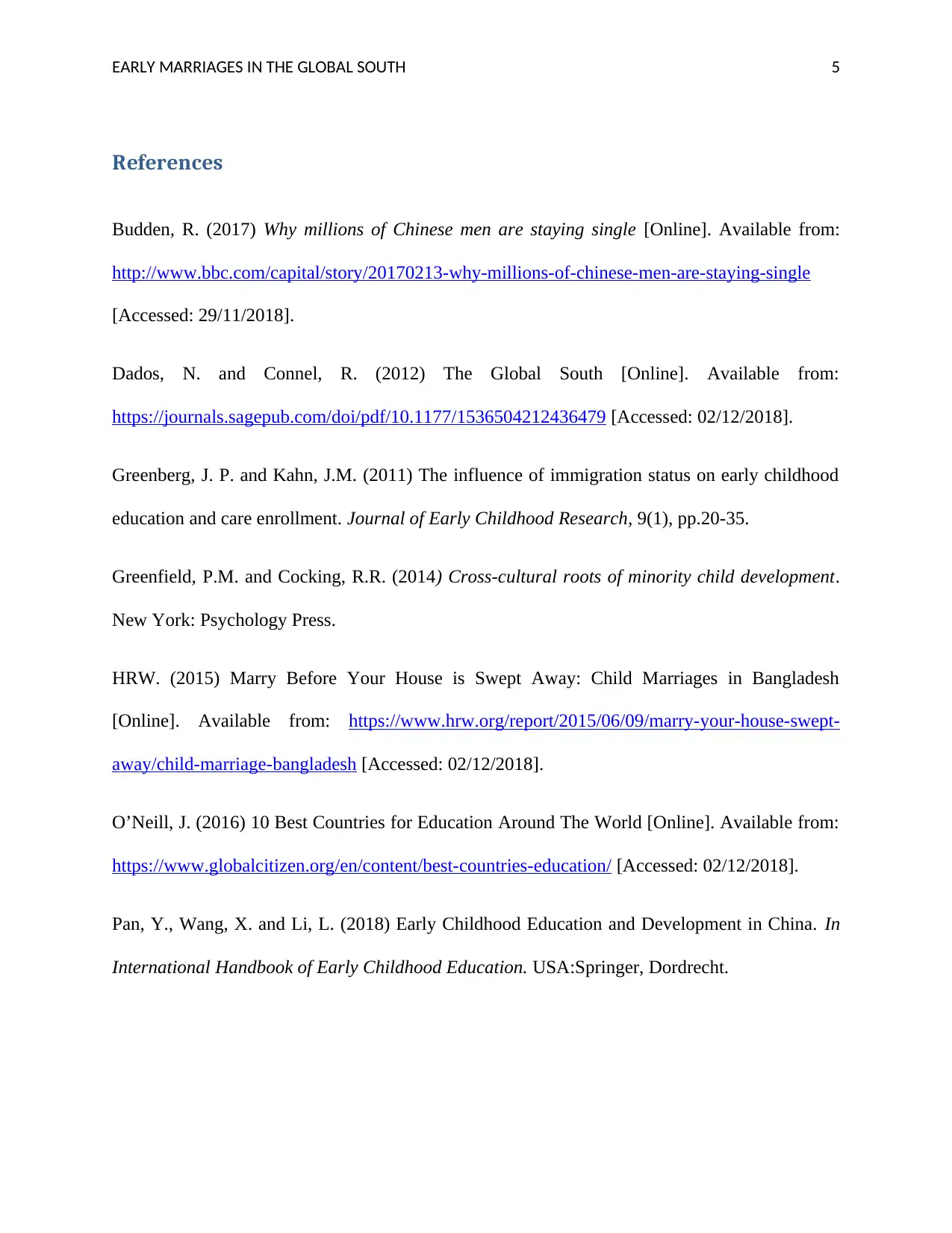
EARLY MARRIAGES IN THE GLOBAL SOUTH 5
References
Budden, R. (2017) Why millions of Chinese men are staying single [Online]. Available from:
http://www.bbc.com/capital/story/20170213-why-millions-of-chinese-men-are-staying-single
[Accessed: 29/11/2018].
Dados, N. and Connel, R. (2012) The Global South [Online]. Available from:
https://journals.sagepub.com/doi/pdf/10.1177/1536504212436479 [Accessed: 02/12/2018].
Greenberg, J. P. and Kahn, J.M. (2011) The influence of immigration status on early childhood
education and care enrollment. Journal of Early Childhood Research, 9(1), pp.20-35.
Greenfield, P.M. and Cocking, R.R. (2014) Cross-cultural roots of minority child development.
New York: Psychology Press.
HRW. (2015) Marry Before Your House is Swept Away: Child Marriages in Bangladesh
[Online]. Available from: https://www.hrw.org/report/2015/06/09/marry-your-house-swept-
away/child-marriage-bangladesh [Accessed: 02/12/2018].
O’Neill, J. (2016) 10 Best Countries for Education Around The World [Online]. Available from:
https://www.globalcitizen.org/en/content/best-countries-education/ [Accessed: 02/12/2018].
Pan, Y., Wang, X. and Li, L. (2018) Early Childhood Education and Development in China. In
International Handbook of Early Childhood Education. USA:Springer, Dordrecht.
References
Budden, R. (2017) Why millions of Chinese men are staying single [Online]. Available from:
http://www.bbc.com/capital/story/20170213-why-millions-of-chinese-men-are-staying-single
[Accessed: 29/11/2018].
Dados, N. and Connel, R. (2012) The Global South [Online]. Available from:
https://journals.sagepub.com/doi/pdf/10.1177/1536504212436479 [Accessed: 02/12/2018].
Greenberg, J. P. and Kahn, J.M. (2011) The influence of immigration status on early childhood
education and care enrollment. Journal of Early Childhood Research, 9(1), pp.20-35.
Greenfield, P.M. and Cocking, R.R. (2014) Cross-cultural roots of minority child development.
New York: Psychology Press.
HRW. (2015) Marry Before Your House is Swept Away: Child Marriages in Bangladesh
[Online]. Available from: https://www.hrw.org/report/2015/06/09/marry-your-house-swept-
away/child-marriage-bangladesh [Accessed: 02/12/2018].
O’Neill, J. (2016) 10 Best Countries for Education Around The World [Online]. Available from:
https://www.globalcitizen.org/en/content/best-countries-education/ [Accessed: 02/12/2018].
Pan, Y., Wang, X. and Li, L. (2018) Early Childhood Education and Development in China. In
International Handbook of Early Childhood Education. USA:Springer, Dordrecht.
⊘ This is a preview!⊘
Do you want full access?
Subscribe today to unlock all pages.

Trusted by 1+ million students worldwide
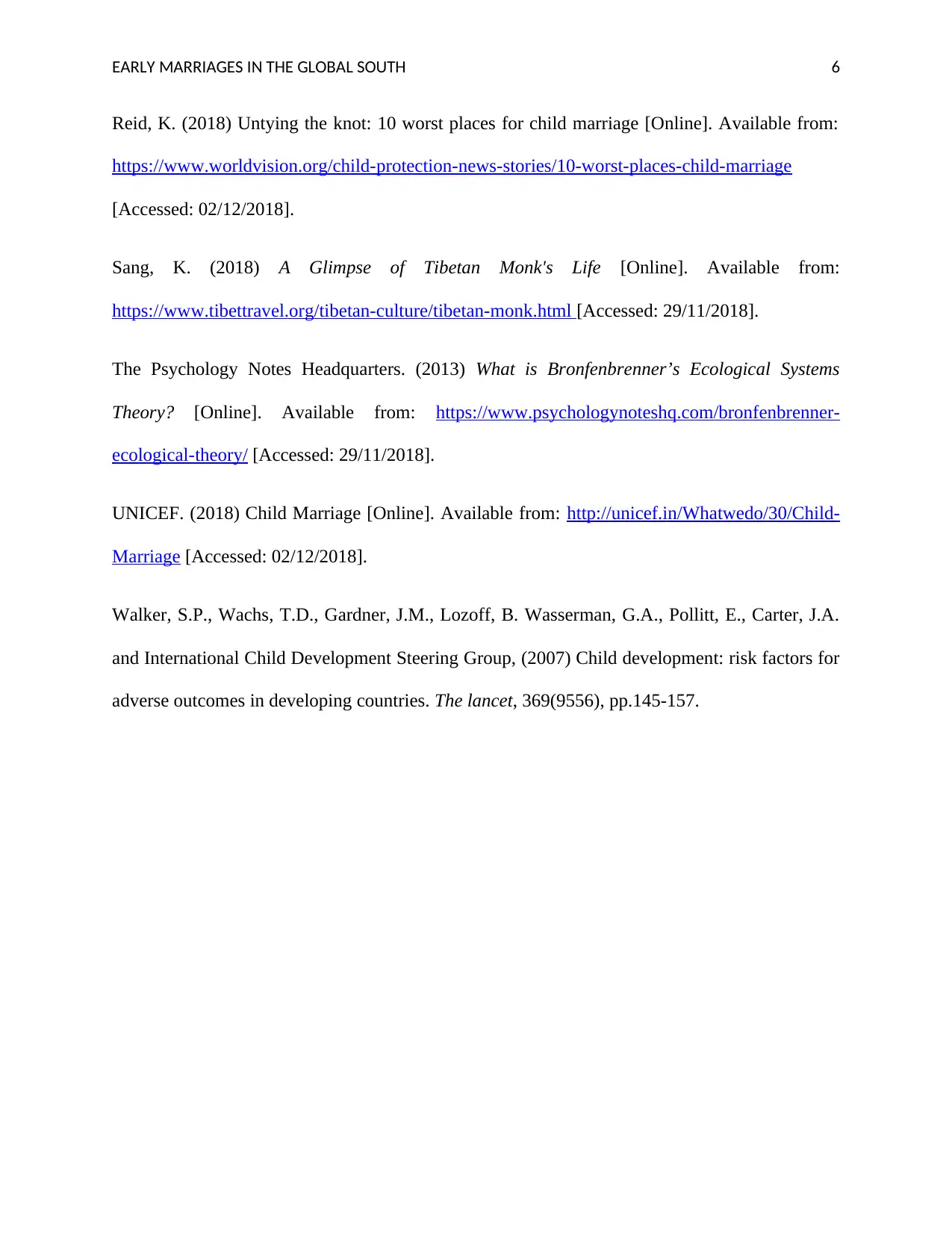
EARLY MARRIAGES IN THE GLOBAL SOUTH 6
Reid, K. (2018) Untying the knot: 10 worst places for child marriage [Online]. Available from:
https://www.worldvision.org/child-protection-news-stories/10-worst-places-child-marriage
[Accessed: 02/12/2018].
Sang, K. (2018) A Glimpse of Tibetan Monk's Life [Online]. Available from:
https://www.tibettravel.org/tibetan-culture/tibetan-monk.html [Accessed: 29/11/2018].
The Psychology Notes Headquarters. (2013) What is Bronfenbrenner’s Ecological Systems
Theory? [Online]. Available from: https://www.psychologynoteshq.com/bronfenbrenner-
ecological-theory/ [Accessed: 29/11/2018].
UNICEF. (2018) Child Marriage [Online]. Available from: http://unicef.in/Whatwedo/30/Child-
Marriage [Accessed: 02/12/2018].
Walker, S.P., Wachs, T.D., Gardner, J.M., Lozoff, B. Wasserman, G.A., Pollitt, E., Carter, J.A.
and International Child Development Steering Group, (2007) Child development: risk factors for
adverse outcomes in developing countries. The lancet, 369(9556), pp.145-157.
Reid, K. (2018) Untying the knot: 10 worst places for child marriage [Online]. Available from:
https://www.worldvision.org/child-protection-news-stories/10-worst-places-child-marriage
[Accessed: 02/12/2018].
Sang, K. (2018) A Glimpse of Tibetan Monk's Life [Online]. Available from:
https://www.tibettravel.org/tibetan-culture/tibetan-monk.html [Accessed: 29/11/2018].
The Psychology Notes Headquarters. (2013) What is Bronfenbrenner’s Ecological Systems
Theory? [Online]. Available from: https://www.psychologynoteshq.com/bronfenbrenner-
ecological-theory/ [Accessed: 29/11/2018].
UNICEF. (2018) Child Marriage [Online]. Available from: http://unicef.in/Whatwedo/30/Child-
Marriage [Accessed: 02/12/2018].
Walker, S.P., Wachs, T.D., Gardner, J.M., Lozoff, B. Wasserman, G.A., Pollitt, E., Carter, J.A.
and International Child Development Steering Group, (2007) Child development: risk factors for
adverse outcomes in developing countries. The lancet, 369(9556), pp.145-157.
1 out of 7
Related Documents
Your All-in-One AI-Powered Toolkit for Academic Success.
+13062052269
info@desklib.com
Available 24*7 on WhatsApp / Email
![[object Object]](/_next/static/media/star-bottom.7253800d.svg)
Unlock your academic potential
Copyright © 2020–2025 A2Z Services. All Rights Reserved. Developed and managed by ZUCOL.





